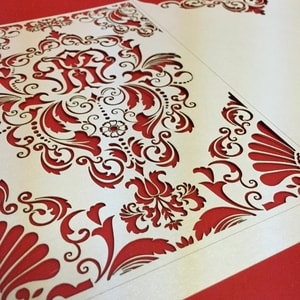On this note, I’m pleased to present one of the basic understandings of kirigami – one of my passions. I am not an expert, so maybe there will be some points are not really accurate. I just would like to share this note to you as a reference.
What is Kirigami? And Kirigami is easy or difficult? How is level of player?
First of all, I would like to explain brief what is Kirigami?
The term of “Kirigami” originally used in paper-cutting art of Japan (of which the main producing process is folding paper into sections, then trimming to create a symmetrical cut paper pattern over 1 center). On 10/12/2010, the first man created paper art club in Vietnam used to name the type of cutting paper (perhaps because it is short and easy to read). Therefore, the term of kirigami is commonly used at present, does not refer to paper cut art comes from Japan only. Because in fact, very few players in Vietnam followed traditional Japanese style of kirigami (even Kirie – Japanese paper cutting painting, seems not very popular.)

In general, paper cutting art is basically divided into:
-Bearly paper cutting: or ZERO degree kirigami. There are several sub categories in this type as silhouette, stencil, china paper cutting… This type is considered cornerstone for the latter development into other types.
–Pop-up cards: 3D cards that can be folded into a flat surface. There are several methods to create 3D cards that can be opened in ranges from 0 to 360 degree. The content in such cards is usually very abundant, basically divided into smaller groups:
+ Outline cutting: It is popular with cards designed by using triangle method combining slice form or multi-layer. Glue is usually used to connect parts of card.
+ Pop up kiri (all motifs are created by cutting, color printing is limited or no used). It’s common with slice form and multi-layer, triangle style is relatively rare. Glue is not used. Latches or interlock links are usually used in such types.
+OA (origami architecture) is presenting architecture on paper, often used slice form (180 degree) or multilayer (90 degree). It is considered a typical group in pop up kirigami.
So how to conclude? Is kirigami easy or difficult?
It’s hard to find out a general answer for this question. There are many players said it’s easy, but no less than say it’s too difficult, it depends on your own. Thus, this post is mainly to discuss the level of kirigami players, hopefully, that it can be a reference to help you evaluating your skill. This ranking is for all categories that I presented previously, because the writer couldn’t have sound knowledge in all of them.
Level 1: Can design based on available patterns.
In kirigami, the cards are usually cut out and finished by the author, then there will be 1 cutting template (pattern) provided to people based on that; they then cut the lines on the paper to complete (0 degrees), or then fold to complete based on a sample of finished products (pop-up). It’s pretty easy for you to reach this level, because anyone can cut the lines on paper. Workmanship is classified based on the cutting speed and sharpness of line cutting, ability to folding 90 degree cards, OA, or attach precisely 180 degree pieces slice form. Proficiency in this level, you have a clear understanding kirigami then. And it also decided your passion to kirigami, you’ll probably give up because it’s too boring, easily, because all you need is simply downloading pattern, printing on paper, then cutting and finishing, (nothing can be easier, right?). But there are also players who learn deeper in this subject, and move on to Level 2.
Level 2 : Can re-design based on the pattern of other authors/ can copy based on the available sample of other ones.
First of all, redrawing a pattern is not a challenge. It does not require a professional drawing skill, or skillfulness. The only requirement is that the understanding of basic principle of kirigami, to explore the method used by the author, then finish the pattern is too simple. And to understand the principles, avoiding errors in the rendering process, they should have experience in cutting and proficiency in cutting ability. Once players have mastered this level, usually forwarded to the next level, few people stop at this level without progress further.
Level 3: Can modify the pattern of others into their styles.
Based on available ideas and methods from their predecessors, players can change according to their own ideas. It requires greater creativity than just redrawing of others. With this level, players partly reflect their own self through work, and can also help distinguish themselves between many other kirigami fans.
Level 4: Can design as your own ideas.
After redrawing the pattern of other authors, having abilities to modify according to their own pattern. Gradually, players can also express their own ideas based on past experience. At this level, the individual mark is expressed most clearly, because it contains the whole idea as your understanding of kirigami, the auxiliary talents like drawing, matching, logic … to achieve this level, then you have one fairly broad understanding of kirigami, for each of category, the simple, the complexity of each method, and choose the method and style appropriate for the charcoal. Once mastered it, you can flatten almost the whole world in your way, can produce your own style, his own image in the community kirigami. Among those who express their own ideas through works in kirigami, there is obviously some people that still keep the style of the author before who they go under, and sometimes difficult to escape from that style, like a trail. But surely, there will be no doubt about love and passion for kirigami of those players.
Level 5: Doing custom designs
You may be wondering, why level 4 is not the highest level. At level 4, every work is customized to author’s style, thus no matter it’s beautiful or not, it’s still achievements of authors. But at this level, on the other, to express the idea of other people, other people’s mark is what left on the paper, combining author’s style and other’s idea into the design is not an easy task, especially when the idea was to not have a deep understanding of this subject. More important, when the work is created, others will be given, give damn it, the designer will have to accept this, like it or not. So surely it is harder in comparison with developing author’s own idea.

